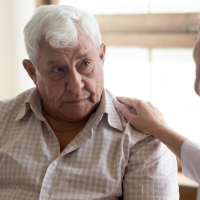Identifying the Triggers of Difficult Behaviors in Dementia Patients

Helping care for loved ones with dementia often means attempting to manage their challenging behaviors. Often, the tiniest actions or changes in their environment can trigger negative reactions. In this piece, we’re going to look at how to begin to determine these triggers and spot patterns that will help you prevent negative behaviors.
Document the Clues Before Attempting to Analyze Them
Like investigating the scene of an accident, it is important to initially put aside theories or hunches about what caused a particular behavior. Instead, simply document the who, what, where, and when details that will help you determine the why.
You may want to take out a notepad or start a note on your mobile device to work through this process.
Step 1: Document the Behavior in Detail
Before we begin to backtrack to the trigger of the behavior, it’s important to document the behavior in detail. Think as though you were reporting the details of an incident you witnessed to the authorities.
Who: Who was present when the behavior began?
What: What happened around your loved one? What specifically did they say? What did they do? What did other people do? What did you do or say in response? Did that help or did it make matters worse?
Where: Where did the behavior take place? Which room? Which part of that room? Which pieces of furniture were nearby?
When: When did this occur? What day of the week? What time of that day? How frequently does this occur? How long does it last?
Now that you have the behavior or incident thoroughly documented, it’s time to do a similar practice of chronicling the moments leading up to that behavior.
Step 2: Document the Moments Before The Moment
Make a similar log of precisely what was happening the moments before the behavior was triggered. Paint the scene of the moments leading up to the negative behavior.
- Where were particular items in the environment placed?
- What was your loved one doing?
- What other things were happening nearby?
Step 3: Look For Patterns
Look at all of the data you have collected and scenes you have painted. Instead of thinking about it from your perspective, look at the details from their perspective. Look for the patterns in what has changed. What may have changed from one moment to the next? Are these changes similar to each other before an incident occurs?
Step 4: Test Your Theories
By now, you’ll likely begin to have theories or hunches about what may be causing the behavior. If you’re having trouble seeing the triggers, remember to look at the scenes you’ve painted from their perspective. Doing so may help you identify something you overlooked because it seemed insignificant to your unimpaired mind.
Once you have a few ideas about what may be triggering these patterns, you can carefully test these hunches by removing what you suspect to be triggering these behaviors.
Once you remove or change these triggers, carefully monitor how your loved one responds. Don’t be surprised if the trigger was something seemingly insignificant or even silly.
Do they no longer have those loud outbursts?
Do they still respond, but differently?
Does their behavior actually get worse? (This is still useful information.)
Continue to monitor their reactions to changing triggers.
Even if you discover the trigger for your loved one’s negative behavior, it’s important to continue to remain perceptive to their reactions. Once you’ve isolated several different triggers for negative behavior, you will likely begin to spot patterns in these triggers that will help you prevent negative behaviors before they occur.
You Have Friends That Care
For additional resources or assistance in caring for loved ones with dementia toward the end of life, your friends at Cura HPC Hospice & Palliative care are here for you.